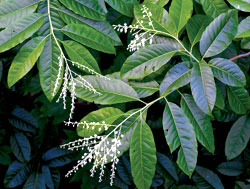I grew up eating sourwood honey on biscuits for breakfast every morning. I guess I was a bit spoiled in that regard. I was in college before it dawned on me that not everyone has sourwood honey every morning for breakfast. Once you taste sourwood, there is really no substitute unless you are fortunate enough to have access to locust honey, an even rarer delicacy. In fact, the lack of access to sourwood honey after my beekeeping uncle died contributed to my becoming a beekeeper myself.

Every time someone asks me, “What is sourwood?” I am amazed. More than a tree or a flavor of honey, it’s almost a state of being. I remember the horror I felt when my dad told me that sourwood trees had once been used to make sleds for teams of horses or mules to haul. The natural crooks in the trees make great sled runners without having to bend the wood. Still, I wondered how anyone could bring themself to cut one down.
Back around 1970, I remember being with my dad in Sugar Hollow, deep into Fairview, where they’d just finished grading for a house he was building. The loader had knocked down a big sourwood tree in full bloom. I was standing over it mourning the loss when I decided to sample the blossoms, figuring maybe they would be tasty too. Some of them did have a faint taste of sourwood nectar, but others didn’t. I now realize that bees have to visit a lot of sourwood blossoms to get much nectar. Studying the blooms, I also saw how they spread down the flower stem from base to end. When the blooms get near the end, you know the window for gathering sourwood nectar is about to close at least until the next year (and that’s assuming the weather cooperates).
Not long afterward, I saw my uncle driving up the road one evening and knew what it meant. He had a couple hundred hives of bees, and it was time for fresh sourwood. I still recall that look in my uncle’s eyes as he showed an extracted jar of honey, exclaiming, “Look how clear this is!” I’ve seen that same look in a beekeeper’s eye many times since then, when they were showing off their sourwood or even just talking about it. Even experienced commercial producers like Edd Buchanan or Greg Rogers still get that look when they talk about their recent harvest. It’s the same one I get—and the one I saw at the beekeepers’ meeting the other night when Tamra Dawsey was telling me about harvesting her first batch. That sweet nectar is a great equalizer, and who wouldn’t be excited about the best honey in the world, which took top honors at the 2005 Apimondia World Congress in Ireland.
I feel sort of sad for those poor souls who don’t know how to tell sourwood from other honey. Many a person wonders what the big deal is after purchasing some so-called sourwood from a fly-by-night artist trying to make a quick buck. Last year at the tailgate market, I had a customer from Paris who explained that her boyfriend is a honey connoisseur and she wanted something special to take home for him. I offered up a jar of my best sourwood, and she recently contacted me to say he’s sampled honey from all over the world and sourwood is the best he’s ever tasted. We are blessed to live right in the middle of sourwood country.
Ironically, mountain laurel—like sourwood a member of the heath family—produces bitter, poison honey. I guess sourwood got all the good in that family, and mountain laurel got all the yuck.
Naturally, beekeepers charge premium prices for this premium honey. But don’t make the mistake of trying to apply world honey-market prices to sourwood. Those prices are for the honey that we have to try to sell somehow.
Maybe I’ve become a bit of a sourwood snob, but this stuff sells itself, and we never have any left over. On the few occasions when someone has complained about my price, I just tell them that it’s their choice—they can buy cheap honey or good honey. If they don’t buy it, someone else will; it’s something you just can’t get at your chain store.
So when you want good sourwood, find a beekeeper who has that look in his eye and you’ll know you’re getting the real deal. But be prepared to hand over some cash: Do you think this stuff just grows on trees?
[Calvin Robinson is vice president of the Buncombe County Beekeeping Chapter. His educational Web site is http://pic5.piczo.com/BeekeeperEducation]


Before you comment
The comments section is here to provide a platform for civil dialogue on the issues we face together as a local community. Xpress is committed to offering this platform for all voices, but when the tone of the discussion gets nasty or strays off topic, we believe many people choose not to participate. Xpress editors are determined to moderate comments to ensure a constructive interchange is maintained. All comments judged not to be in keeping with the spirit of civil discourse will be removed and repeat violators will be banned. See here for our terms of service. Thank you for being part of this effort to promote respectful discussion.